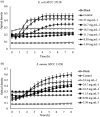Phytochemical characterization, and antioxidant and antimicrobial activities of white cabbage extract on the quality and shelf life of raw beef during refrigerated storage
- PMID: 35516557
- PMCID: PMC9057788
- DOI: 10.1039/d0ra06727j
Phytochemical characterization, and antioxidant and antimicrobial activities of white cabbage extract on the quality and shelf life of raw beef during refrigerated storage
Abstract
Brassica vegetables are well-characterized, containing a wide-spectrum of phenolic compounds that are responsible for their diverse biological activities like antioxidant and antimicrobial activities. This study explored the preservative effect of Brassica oleracea var. capitate f. alba (white cabbage; WC) on beef under refrigerated conditions for 16 days. The antimicrobial activities of WC were evaluated against foodborne pathogenic bacteria and fungi. The antioxidant activity was determined on the basis of total phenolic and flavonoid contents, through employing DPPH and ABTS assays. The chemical composition was analyzed by GC-MS analysis. The results indicated that among the different solvent extracts, white cabbage chloroform extract [WCCE] exhibited outstanding bioactive properties due to the presence of 4-nitro-3-(trifluoromethyl)phenol, and the effects of WCCE at different levels (A and B) on the quality and shelf life of beef in storage were evaluated. The color parameters (lightness, yellowness, and redness), texture analysis, and pH values were monitored constantly with 4 days interval, and microbial analysis was conducted. The results showed that WCCE-A treatment significantly reduced the total viable counts, psychrotrophic bacteria, and yeast-molds when compared with WCCE-B and control during refrigeration storage, with the activity varying in a dose-dependent manner (p < 0.05). Significantly, the WCCE-A treatments had better appearance compared with the control after 16 days of storage. All results confirmed that WCCE which is rich in bioactive compounds, effectively maintains the quality of beef compared to the control by retarding lipid oxidation and microbial growth at refrigeration temperature and also emphasize the potential applications of this plant in different industrial sectors.
This journal is © The Royal Society of Chemistry.
Conflict of interest statement
The authors declare no conflict of interest.
Figures






References
-
- Kim S.-J. Cho A. R. Han J. Food Control. 2013;29:112–120. doi: 10.1016/j.foodcont.2012.05.060. - DOI
-
- Khan I. Tango C. N. Oh D.-H. Int. J. Food Sci. Technol. 2017;52:1111–1121. doi: 10.1111/ijfs.13379. - DOI
-
- Bazargani-Gilani B. Aliakbarlu J. Tajik H. Innovative Food Sci. Emerging Technol. 2015;29:280–287. doi: 10.1016/j.ifset.2015.04.007. - DOI
LinkOut - more resources
Full Text Sources
Molecular Biology Databases
Miscellaneous

